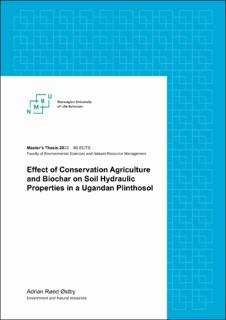| dc.description.abstract | Conservation agriculture (CA) is regarded as a robust and resilient agricultural practice, able to meet the challenges related to climate change. Conservation farming in combination with biochar (BC) has gained increased interest over the past years as biochar has been demonstrated to improve several soil physical parameters. This study is based on an in-field trial site under a randomized block design with a total of 24, 4 x 3 m plots, located in the Alebtong district, Uganda. Here we assess how treatments of CA, CA with the addition of BC (CA+BC) and conventional practice (Conv.) affect soil water retention, infiltration, soil bulk density (BD) and soil chemical properties. Additionally, a lab trial was conducted at The Norwegian University of Life Sciences to assess the effect of pigeon pea biochar and maize cob biochar on soil water retention.
The in-field results from treatments under CA showed a significant decrease in BD compared to CA+BC and Conv. The plant available water content (PAWC) did not significantly increase in any of the treatments. However, the water content at permanent wilting point was significantly lower under CA as compared to the other treatments. The results from CA+BC treatments were inconclusive due to lack of BC in the soil samples.
Results from the lab trial showed a significant increase in volumetric PAWC under 10 % pigeon pea biochar treatments, compared to maize cob biochar treatments and control. Both types of BC significantly decreased BD. No significant differences were observed between BC particle sizes on PAWC. However, an indication of greater PAWC was noticeable for the finer BC particles for both BC types. There is uncertainty linked to the maize cob biochar treatments, assumed to be a result of inconsistent saturation time and likely the degree of eventual saturation of the samples. | |
